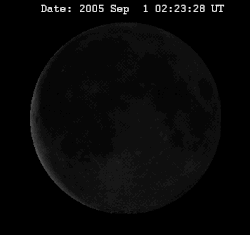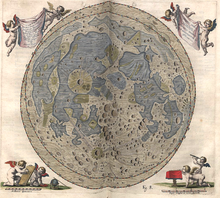Libration

In astronomy , libration refers to a real or apparent tumbling motion of a moon , seen from its central body.
Almost all of the larger moons of the solar system are in a bound rotation around their central planet, that is, they turn once around their own axis during an orbit around the planet. Therefore these moons always turn the same side of their planet in principle. However, since the moons do not orbit their planets on exact circular orbits at a constant angular velocity , while their own rotation has a constant angular velocity, and since an observer on the planet does not have to be exactly on the line connecting the centers of mass, the observer sees in the course of a "month" not always exactly the same side of the moon. In the case of the earth's moon, a total of 59 percent of the moon's surface can be seen from the earth's surface over time due to the various effects that lead to this tumbling movement.
description

A distinction is made between the following types of libration, here using the example of the earth's moon :
- Optical libration
- The length of the libration shows itself as a lateral rotation of a maximum of 7.9 degrees and is mainly caused by the slightly elliptical orbit of the moon. If the lunar orbit were circular, its angular velocity ("degrees per second") would always be the same. Because of the elliptical orbit, the distance between the earth and the moon ( pericenter distance ) changes during an orbit, and thus also the angular velocity. According to Kepler's 2nd law , the smaller the distance, the greater the distance - i.e. the greatest near the earth . However, the rotation speed of the moon around its own axis remains constant. This is why the moon rotates too slowly near the earth and faster than its orbit when it is further away. Other small libration effects arise from the change in the orbit of the moon due to the forces of attraction of the sun and planets.
- The angle of the axis of rotation of the moon with respect to the perpendicular to the plane of the moon's orbit (not to the perpendicular of the plane of the earth's orbit!) Is responsible for the latitude libration . It is 6.7 degrees and causes the moon to tilt vertically so that you can see alternately across its north and south poles.
- The parallactic or daily libration is caused by the rotation of the earth and is about one degree. From moonrise to moonset, the earth rotates 180 degrees. Each point on the earth's surface moves, depending on the geographical latitude, by up to 12,756 km (one earth diameter ). When the moon rises, an observer sees the moon from a slightly different position and thus from a different viewing angle than 12 hours later when the moon sets.
- Physical libration
- In physical libration , the earth's gravitation through tidal forces actually causes the moon to move slightly. But it is only a maximum of 0.04 degrees.
calculation
The optical libration can be calculated to a good approximation from the celestial mechanical properties of the earth-sun-moon system. If one neglects the influence of the sun as a first approximation, the following values are obtained from the solution of the two-body problem earth-moon:
- The " great inequality " is relevant for the libration in length . This is the difference between true anomaly ; H. the angle between the perigee and the moon seen from the earth, and mean anomaly , d. H. the angle between perigee and the "middle" moon. The middle moon moves with the constant angular velocity , where stands for the anomalistic month . The large inequality is then approximately sufficient for small eccentricities of the formula in radians , where the numerical eccentricity is the lunar orbit. In degrees results numerically
- .
- The axis inclination of the moon in relation to its orbit is responsible for the libration in latitude and is therefore where the axis inclination is and denotes the angle between the moon and the ascending node of the lunar orbit. It should be noted at this point that the axis inclination of the moon and the orbital inclination share the nodes with each other, so that always , i.e. H. Orbit inclination (5.145 °) and inclination of the lunar axis against the ecliptic (1.543 °) add up to the axis inclination (see Cassini's laws ). thats why
- The period of this libration is the draconian month .
The major disturbances in the earth-moon system, primarily caused by the sun, cause additional deviations, the most important of which are the following:
- The length of the libration is disturbed by the evection known to Ptolemy by a maximum of 1.27 °. The reason is the different position of the apse line to the sun. The period of this disorder is 31.8 days. The variation is slightly smaller with a maximum of 0.66 °. The period of this perturbation is half a synodic month, and the variation disappears towards the main phases of the moon. The formula results
- ,
- where with as synodic month .
- Maximum libration of about 7.72 ° in length can only occur if the apsidal line is at a certain angle to the earth-sun axis.
- The length of the libration is subject to fluctuations, as the orbital inclination of the moon changes between 4.6 ° and 5.3 ° with a period of 173 days. The period of 173 days is the time in which the nodal line rotates 180 ° in relation to the sun (half an eclipse year ).
literature
- Hans-Heinrich Voigt : Outline of the astronomy . Ed .: Hermann-Josef Röser. 6th substantially revised and expanded edition. Wiley-VCH , Weinheim an der Bergstrasse 2010, ISBN 978-3-527-40736-1 (first edition 1969 at Bibliographisches Institut , Mannheim).
Web links
- Karl-Heinz Bücke: The Libration of the Moon. Astronomie.de, September 2001, accessed on May 16, 2017 .
- Lunation - Astronomy Picture of the Day of November 8, 1999.
- Lunacycle: Photographing and Animating a Lunar Cycle. ( Memento from May 15, 2013 in the Internet Archive ) On: Forrest-Tanaka.com. Beautiful photographic representation of the moon's orbit and explanation of libration and a. (English).
- Video of the moon's libration for the whole of 2013
- Video of the moon's libration for the entire year 2014
- Video of the moon's libration for the whole of 2016
- Spektrum.de : Amateur recordings [1]














